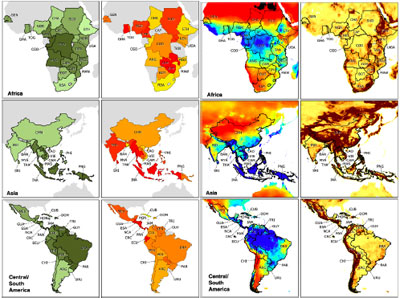Forests reduce flooding
Forests reduce flooding
mongabay.com
October 4, 2007
While conventional wisdom holds that forests help buffer against catastrophic flooding, there has been little evidence to support such notions. A 2005 report by the Food and Agricultural Organization of the United Nations (FAO) and the Center for International Forestry Research (CIFOR) cited this lack of evidence and argued that flood mitigation efforts though forest preservation could not be justified on economic grounds. Now, a new study, published in the journal Global Change Biology, suggests that forests do impact the occurrence and severity of destructive floods. A prominent researcher is already calling the new work a “landmark study” in support of forest conservation.
Analyzing data from 56 developing countries and controlling for differences in rainfall, elevation, soil moisture and degraded areas, researchers from Charles Darwin University in Australia and the National University of Singapore found that a 10 percent increase in deforestation results in a 4-28 percent increase in flood frequency.
|
Data used in the study. Courtesy of the authors |
“Based on an arbitrary decrease in natural forest area of 10%, the model-averaged prediction of flood frequency increased between 4% and 28% among the countries modeled,” wrote the researchers. “Using the same hypothetical decline in natural forest area resulted in a 4—8% increase in total flood duration.”
The study further showed that natural forest is more effective than plantations in reducing flooding.
“An important additional finding was that only the amount of native forest was correlated with reductions in flood risk — plantation forests had the opposite effect”, said lead author Dr. Cory Bradshaw of Charles Darwin University.
Deforestation amplifies flood damage
The researchers also examined how deforestation affects the severity of flooding, by comparing flood damage and death tolls in countries with varying degrees of forest cover.
“We found real evidence that deforestation also leads to more intense and devastating floods that kill more people and damage more property”, said Bradshaw.
The results suggest that continuing deforestation could worsen floods in the tropics.
“Unabated loss of forests may increase or exacerbate the number of flood-related disasters, negatively impact millions of poor people, and inflict trillions of dollars in damage in disadvantaged economies over the coming decades,” the authors write, noting that during the decade investigated, “nearly 100 000 people were killed and 320 million people were displaced by floods, with total reported economic damages exceeding US$1151 billion.”
Still, the study offers hope that forest protection and reforestation could help mitigate floods as well as provide ancillary benefits including biodiversity conservation and carbon sequestration.
“This has huge implications for governments of developing nations trying to save lives and reduce expenditures,” explained Bradshaw. “Promoting native forest conservation also has the added benefits of slowing climate change by storing huge quantities of carbon, reducing wildfires, and conserving species.”
Dr. William Laurance, a senior researcher at the Smithsonian Tropical Research Institute (STRI) in Panama, agrees.
“In my view, Bradshaw and colleagues’ paper will turn out to be a landmark study,” wrote Laurance in a review of the research published in Nature. “The study’s ambitious geographical scope and statistical rigour make it persuasive… The findings add to other evidence that large expanses of native forest can have major benefits not only for reducing floods, but also for limiting wild fires, conserving biodiversity, and slowing regional and global climate change.”
Citation: COREY J. A. BRADSHAW, NAVJOT S. SODHI, KELVIN S.-H. PEH and BARRY W. BROOK (2007). Global evidence that deforestation amplifies flood risk and severity in the developing world. Global Change Biology (2007) 13, 1—17
William F. Laurance (2007). Forests and floods. Nature Vol 449|27 September 2007








